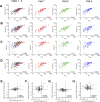This is a preprint.
Longitudinal analysis of clinical serology assay performance and neutralising antibody levels in COVID19 convalescents
- PMID: 32793928
- PMCID: PMC7418752
- DOI: 10.1101/2020.08.05.20169128
Longitudinal analysis of clinical serology assay performance and neutralising antibody levels in COVID19 convalescents
Update in
-
Longitudinal Serological Analysis and Neutralizing Antibody Levels in Coronavirus Disease 2019 Convalescent Patients.J Infect Dis. 2021 Feb 13;223(3):389-398. doi: 10.1093/infdis/jiaa659. J Infect Dis. 2021. PMID: 33140086 Free PMC article.
Abstract
Objectives: To investigate longitudinal trajectory of SARS-CoV-2 neutralising antibodies and the performance of serological assays in diagnosing prior infection and predicting serum neutralisation titres with time Design Retrospective longitudinal analysis of a COVID19 case cohort . Setting NHS outpatient clinics Participants Individuals with RT-PCR diagnosed SARS-CoV-2 infection that did not require hospitalization Main outcome measures The sensitivity with which prior infection was detected and quantitative antibody titres were assessed using four SARS-CoV-2 serologic assay platforms. Two platforms employed SARS-CoV-2 spike (S) based antigens and two employed nucleocapsid (N) based antigens. Serum neutralising antibody titres were measured using a validated pseudotyped virus SARS-CoV-2 neutralisation assay. The ability of the serological assays to predict neutralisation titres at various times after PCR diagnosis was assessed. Results The three of the four serological assays had sensitivities of 95 to100% at 21-40 days post PCR-diagnosis, while a fourth assay had a lower sensitivity of 85%. The relative sensitivities of the assays changed with time and the sensitivity of one assay that had an initial sensitivity of >95% declined to 85% at 61-80 post PCR diagnosis, and to 71% at 81-100 days post diagnosis. Median antibody titres decreased in one serologic assay but were maintained over the observation period in other assays. The trajectories of median antibody titres measured in serologic assays over this time period were not dependent on whether the SARS-CoV-2 N or S proteins were used as antigen source. A broad range of SARS-CoV-2 neutralising titres were evident in individual sera, that decreased over time in the majority of participants; the median neutralisation titre in the cohort decreased by 45% over 4 weeks. Each of the serological assays gave quantitative measurements of antibody titres that correlated with SARS-CoV-2 neutralisation titres, but, the S-based serological assay measurements better predicted serum neutralisation potency. The strength of correlation between serologic assay results and neutralisation titres deteriorated with time and decreases in neutralisation titres in individual participants were not well predicted by changes in antibody titres measured using serologic assays.
Conclusions: SARS-CoV-2 serologic assays differed in their comparative diagnostic performance over time. Different assays are more or less well suited for surveillance of populations for prior infection versus prediction of serum neutralisation potency. Continued monitoring of declining neutralisation titres during extended follow up should facilitate the establishment of appropriate serologic correlates of protection against SARS-CoV-2 reinfection.
Conflict of interest statement
Competing interest statement
All authors have completed the Unified Competing Interest form (available on request from the corresponding author) and declare: no support from any organisation or financial relationships with any organisations that might have an interest in the submitted work in the previous three years, no other relationships or activities that could appear to have influenced the submitted work.
Figures



References
Publication types
Grants and funding
LinkOut - more resources
Full Text Sources
Miscellaneous
